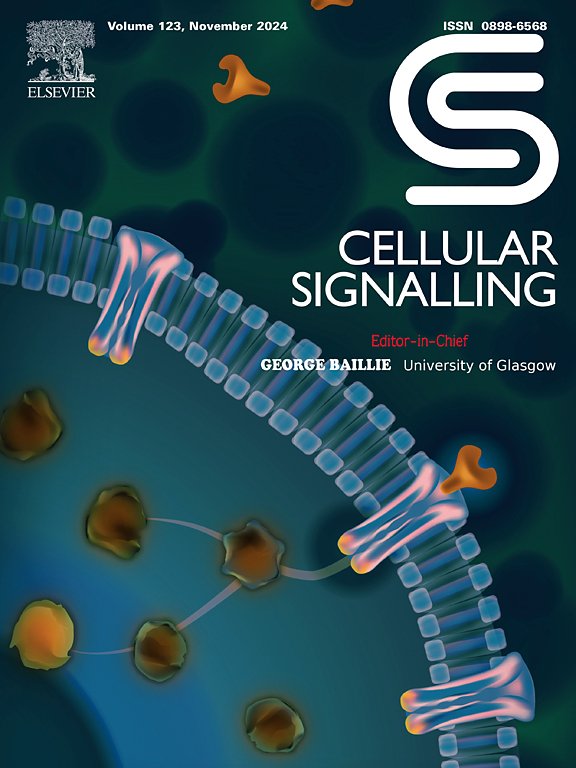Histone methyltransferase G9a drives ferroptosis to aggravate vascular calcification by inhibiting SLC7A11 transcription
IF 3.7
2区 生物学
Q2 CELL BIOLOGY
引用次数: 0
Abstract
Vascular calcification (VC) exacerbates the risk of cardiovascular morbidity and mortality in individuals with chronic kidney disease (CKD), and recent advances in pathogenesis have highlighted the significance of ferroptosis. The histone methyltransferase G9a participates in the regulation of different types of cell death including ferroptosis, but its role in VC needs to be further explored. Here, we found that G9a expression was elevated in microarray data obtained from CKD mouse VSMC specimens, and further experiments demonstrated similar results in CKD patients, mouse calcified arteries and rat calcified VSMCs. Functionally, G9a overexpression promoted high calcium and phosphate-induced VSMCs calcification, whereas G9a deficiency had a protective effect. Moreover, our results confirmed that G9a promoted VSMCs calcification through cystine pathway-mediated ferroptosis. Mechanistically, histone H3 lysine 9 dimethylation (H3K9me2) which was catalyzed by G9a, interacted with the promoter of solute carrier family 7 member 11 (SLC7A11) to inhibit its transcription and ferroptosis-related signaling pathways. SLC7A11, a cysteine transporter and ferroptosis suppressor, eliminated the adverse effects of G9a overexpression on ferroptosis and VC in VSMCs. Finally, in vivo overexpression of G9a aggravated VC and ferroptosis in the aorta of CKD mice, accompanied by down-regulation of SLC7A11 expression. In summary, our study reveals that the G9a/H3K9me2/SLC7A11 pathway is a new molecular mechanism for ferroptosis in VC, offering potential guidance for the development of new strategies in the treatment of VC.

组蛋白甲基转移酶G9a通过抑制SLC7A11的转录,驱动铁下沉加重血管钙化。
血管钙化(VC)加剧了慢性肾脏疾病(CKD)患者心血管发病率和死亡率的风险,最近在发病机制方面的进展强调了铁下垂的重要性。组蛋白甲基转移酶G9a参与包括铁凋亡在内的不同类型细胞死亡的调控,但其在VC中的作用有待进一步探讨。在这里,我们发现从CKD小鼠VSMC标本中获得的微阵列数据中G9a表达升高,进一步的实验表明,CKD患者、小鼠钙化动脉和大鼠钙化VSMC中也有类似的结果。在功能上,G9a过表达促进高钙和高磷酸盐诱导的VSMCs钙化,而G9a缺乏具有保护作用。此外,我们的研究结果证实G9a通过胱氨酸途径介导的铁下垂促进VSMCs钙化。机制上,由G9a催化的组蛋白H3赖氨酸9二甲基化(H3K9me2)与溶质载体家族7成员11启动子(SLC7A11)相互作用,抑制其转录和凋亡相关信号通路。SLC7A11是一种半胱氨酸转运蛋白和铁下垂抑制因子,消除了G9a过表达对VSMCs铁下垂和VC的不利影响。最后,体内过表达G9a加重了CKD小鼠主动脉VC和铁下垂,并伴有SLC7A11表达下调。综上所述,我们的研究揭示了G9a/H3K9me2/SLC7A11通路是VC中铁凋亡的一个新的分子机制,为VC治疗新策略的开发提供了潜在的指导。
本文章由计算机程序翻译,如有差异,请以英文原文为准。
求助全文
约1分钟内获得全文
求助全文
来源期刊

Cellular signalling
生物-细胞生物学
CiteScore
8.40
自引率
0.00%
发文量
250
审稿时长
27 days
期刊介绍:
Cellular Signalling publishes original research describing fundamental and clinical findings on the mechanisms, actions and structural components of cellular signalling systems in vitro and in vivo.
Cellular Signalling aims at full length research papers defining signalling systems ranging from microorganisms to cells, tissues and higher organisms.
 求助内容:
求助内容: 应助结果提醒方式:
应助结果提醒方式:


